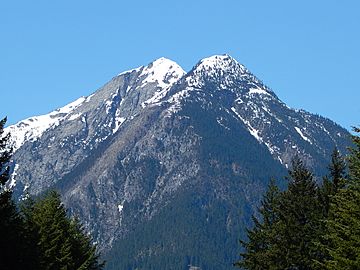Ruby Mountain (Washington) facts for kids
Quick facts for kids Ruby Mountain |
|
|---|---|

Ruby Mountain, east aspect
|
|
| Highest point | |
| Elevation | 7,412 ft (2,259 m) NAVD 88 |
| Prominence | 3,888 ft (1,185 m) |
| Isolation | 4.24 mi (6.82 km) |
| Parent peak | Red Mountain (7,658 ft) |
| Geography | |
| Location | |
| Parent range | North Cascades |
| Topo map | USGS Ross Dam |
| Climbing | |
| First ascent | 1916 Tommy Thompson |
| Easiest route | Scrambling |
Ruby Mountain is a tall mountain peak in the North Cascades mountains of Washington State. It stands about 7,412 feet (2,259 meters) high. This mountain is found inside the Ross Lake National Recreation Area, which is part of the larger North Cascades National Park Complex.
You can see Ruby Mountain from the North Cascades Highway at the Diablo Lake Overlook. The closest taller mountain is Colonial Peak, which is about 4.2 miles (6.8 kilometers) to the southeast. Water from the east side of Ruby Mountain flows into Ross Lake through Ruby Creek. Water from the west side flows into Diablo Lake through Thunder Creek.
Mountain Weather: Ruby Mountain's Climate
Ruby Mountain is located in a special climate zone called the marine west coast climate. This type of climate is found in western North America. Most of the weather that affects the mountain comes from the Pacific Ocean. These weather systems travel northeast towards the Cascade Mountains.
When these weather systems reach the North Cascades, the tall peaks force the air upwards. This process is called Orographic lift. As the air rises, it cools down and drops its moisture as rain or snow. Because of this, the western side of the North Cascades gets a lot of rain and snow, especially in winter.
Thanks to the ocean's influence, the area rarely gets extremely cold (below 0°F or -18°C) or very hot (above 80°F or 27°C). Winters are usually cloudy, but summers often have clear skies because of high-pressure systems over the Pacific Ocean. The snow here tends to be wet and heavy, which can increase the risk of avalanches.
How Ruby Mountain Was Formed: Geology
The North Cascades mountains have very rugged land. You can see sharp peaks, long ridges, and deep valleys carved by glaciers. These amazing landscapes and big changes in height were created by geological events millions of years ago. These events also led to different climates and types of plants in the area.
The Cascade Mountains started forming millions of years ago, during a time called the late Eocene Epoch. This happened because the North American Plate was slowly moving over the Pacific Plate. This movement caused many volcanic eruptions and created new rocks.
Also, small pieces of the Earth's crust, called terranes, came together to form the North Cascades about 50 million years ago.
During the Pleistocene period, which was over two million years ago, large glaciers moved across the land many times. As they moved, they scraped and shaped the landscape, leaving behind piles of rock. The river valleys in the area now have a "U" shape, which is a clear sign of these past glaciers. The combination of land being pushed up (called uplift) and cracks in the Earth's crust (called faulting), along with the glaciers, created the tall peaks and deep valleys we see in the North Cascades today.


